What is the true armyworm?
True armyworm (Mythimna unipuncta) is a pest of corn and small grains known for migrating in large groups when its preferred food source is depleted. The adult moths lay their eggs in lush, green grasses, and the larvae primarily feed on grasses, especially barley, corn, oats, rye and wheat. Pastures and grassy hay fields are also at risk of damage.
What do true armyworms look like?
Egg: True armyworm eggs are small, greenish-white, and spherical. They are laid in rows or clusters on lush, green grasses. The eggs darken before hatching.
Larva: The larvae range from brownish-green to black, with orange, brown, and white stripes running lengthwise on the sides (Figure 1). Dark and light stripes alternate along their backs. The head is light brown with dark markings. Full-grown larvae are about 2.0 inches long.

Pupa: True armyworm pupae are dark brown and about 0.75 of an inch long.
Adult: The adult moths are beige with a wingspan of about 1.5 inches (Figure 2). The moths are identifiable by a distinctive white dot in the center of each forewing.
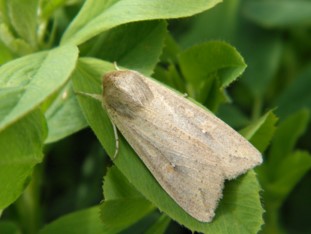
Life cycle and biology of true armyworm
Armyworms do not overwinter in Wisconsin. Instead, the moths migrate from the milder climate of the southern United States and northern Mexico, returning each spring with weather systems. The Wisconsin Department of Agriculture, Trade and Consumer Protection (DATCP) tracks the timing of true armyworm arrival and moth flights in Wisconsin through its True Armyworm Monitoring Network.
Starting in April, they produce two or three generations per season in Wisconsin. Each larval generation lasts five to six weeks. The first generation is usually small but can cause economic damage to wheat and corn planted after grass cover crops. A successful first generation may also give rise to an even more destructive second generation of larvae. The second generation of larvae in July is typically the largest and most damaging.
True armyworm moths are nocturnal and lay their eggs in the evening on leaf blades of their host plants. The eggs hatch after seven to 10 days, and the larvae then feed on corn and wheat foliage, as well as grass in hay fields or pastures, for about 25 days. Armyworm larvae develop through six instars before pupating for approximately 14 days and emerging as moths (Figure 3).

What are the symptoms of true armyworm damage?
True armyworms feed at night or on cloudy days on the leaf tissue of plants. In severe cases, true armyworm larvae can entirely strip the leaves.
First-generation armyworm infestations in June can be found by scouting field margins for corn leaves with ragged edges. The irregular, ragged chewing pattern along the leaf edge is a telltale sign of armyworm feeding (Figure 4). Closely check corn plants for larvae and frass in the whorls. Also pay attention to lodged areas of wheat and small grains fields.
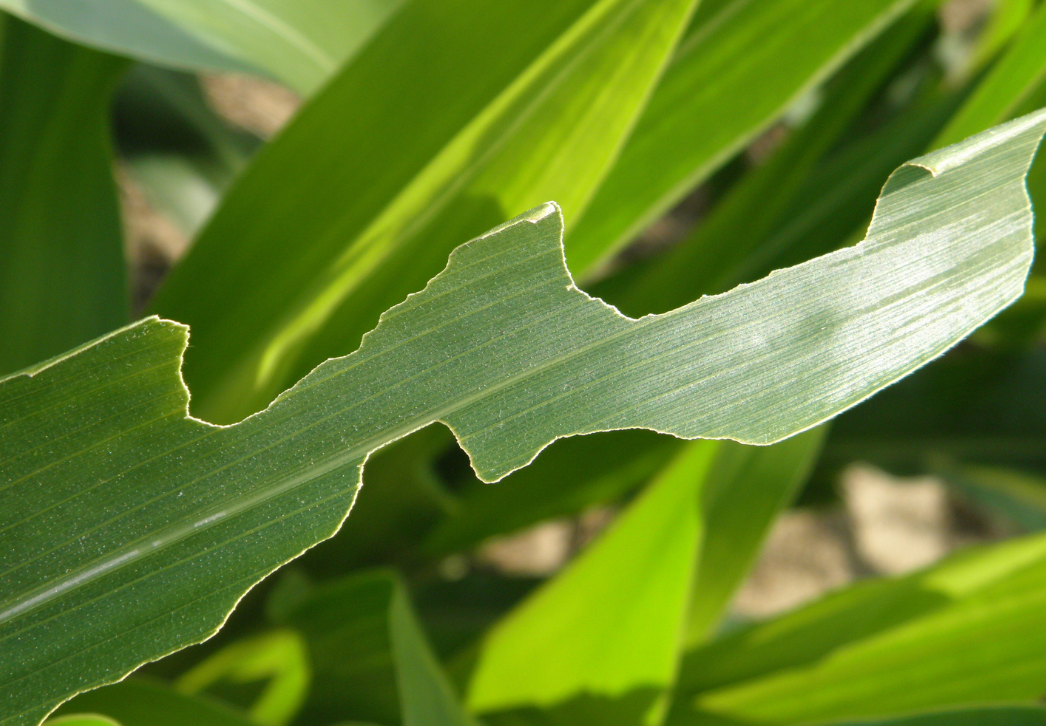
Second-generation infestations in July may occur throughout a corn field if grassy weeds (e.g., foxtails, quackgrass, and nutsedge) are abundant in between rows for egg laying. Signs of feeding include plants with ragged leaves or brown frass, and the larvae can often be found inside the whorl or leaf axils (Figure 5). Damage is usually highest along field edges or in grassy spots. In wheat and other small grains, the larvae feed on grassy weeds and on the leaves of host plants and may clip off the grain heads. The larvae are difficult to detect and hide in crop debris on the ground or under soil clods, particularly in lodged areas of small grains fields.

If a food source is depleted or overcrowding occurs, the larvae display mass migration behavior and move in large numbers to nearby fields. This behavioral change is what gives the armyworm its name.
How do you scout for true armyworms?
Corn should be scouted in early June and again in July for signs of true armyworm feeding, taking care to look for leaves with ragged edges and for larvae in the whorls. Check five sets of 20 plants around the field at random for the presence of larvae or leaf feeding. Be sure to check plants in the edge rows for signs of armyworm activity. If larvae are found, repeat in several more locations since infestations may be spotty. Also note the size of the larvae.
In small grains, examine three feet of a row in five different areas of the field. Shake the plants vigorously to dislodge the larvae, count the number found and note their size. For wheat and grain fields in the vegetative stages, a sweep net can be used to check for larvae.
What is the threshold for true armyworm treatment?
The threshold for corn is 25% of plants with two larvae (less than 0.75 inch long) or 75% of plants with one larva. In small grains, the threshold is three larvae per square foot. Spot treat only the border rows when possible.
Treatment thresholds are not based on moth flights. DATCP’s True Armyworm Monitoring Network provides updates on true armyworm moth migration and captures across the state. This information is used to determine the arrival of true armyworm in Wisconsin and to forecast the optimal time to scout for larvae.
Integrated pest management (IPM) strategies for true armyworm
Cultural Control
Fall termination of forage crops in rotation with corn is a good way to reduce egg-laying sites in the spring. Controlling grassy weeds in fields can have the same effect if done before the eggs are laid in early April.
Biological Control
Certain species of ground beetles and parasitic wasps can help limit true armyworm populations. The red-tailed tachinid fly (Winthemia quadripustulata) is a very effective biological control that lays noticeable fuzzy eggs on the backs of armyworm larvae. The fly eggs hatch and the larvae burrow into the armyworm, eventually killing it. This fly frequently parasitizes armyworms in Wisconsin and can drastically reduce populations by 50-100% in just a few days.

Chemical Control
Refer to Pest Management in Wisconsin Field Crops (A3646) for insecticides labeled for true armyworm control in corn (p. 59), pasture, alfalfa (p. 175) and small grains (p. 195). Always read and follow the pesticide label.
For any crop, chemical treatment is only suggested if the larvae are 0.75 of an inch or smaller because larger true armyworms do not respond to insecticide. Be mindful that larvae may migrate from grasses to host crops if a food source is depleted (e.g., herbicide applied to kill grassy weeds).
True armyworm response and management options
Monitor weather conditions and crop growth stage to determine optimal timing for insecticide applications, as needed.
Apply insecticides according to label instructions and consider factors such as application method, rate, and pre-harvest and pre-grazing intervals.
Environmental and ecological considerations for true armyworm treatment
Your field might be at higher risk for true armyworm damage if you:
- Plant corn after grass cover crops (e.g., cereal rye)
- Plant corn into a no-tilled alfalfa field
- Have grassy, weedy areas in the field
Minimize pesticide use whenever possible to reduce potential impacts on non-target organisms and environmental health.
Implement IPM practices that promote biological diversity and ecosystem resilience.
References
Additional resources
Use information from DATCP’s True Armyworm Monitoring Network to track the timing of true armyworm arrival in Wisconsin to optimally time field scouting.
Sign up for Insect Pest Text Alerts from the Bick Lab at UW-Madison to be alerted about true armyworm in your area.
For assistance with true armyworm management and other agricultural pest issues, contact your local agricultural extension office.
Last Updated: June 18, 2025
Reviewed by: Krista Hamilton (DATCP) and Laura Flandermeyer
Featured cover photo by Krista Hamilton.


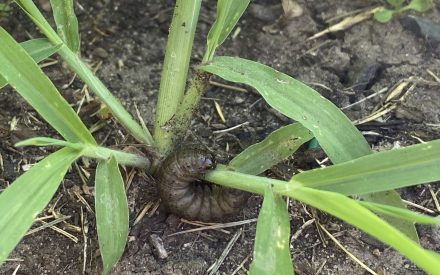 Managing Black Cutworm in Wisconsin Corn Fields
Managing Black Cutworm in Wisconsin Corn Fields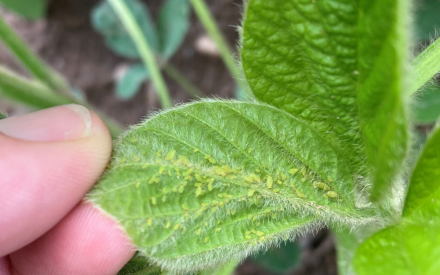 Managing Soybean Aphids in Wisconsin Soybean Fields
Managing Soybean Aphids in Wisconsin Soybean Fields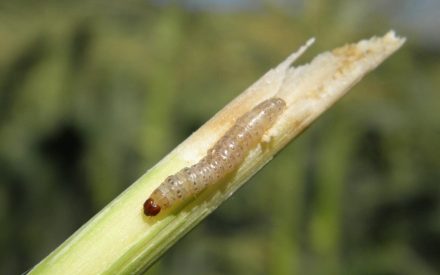 Managing European Corn Borer in Wisconsin Corn Fields
Managing European Corn Borer in Wisconsin Corn Fields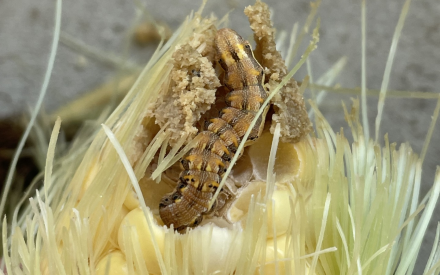 Managing Corn Earworm in Wisconsin Corn Fields
Managing Corn Earworm in Wisconsin Corn Fields


